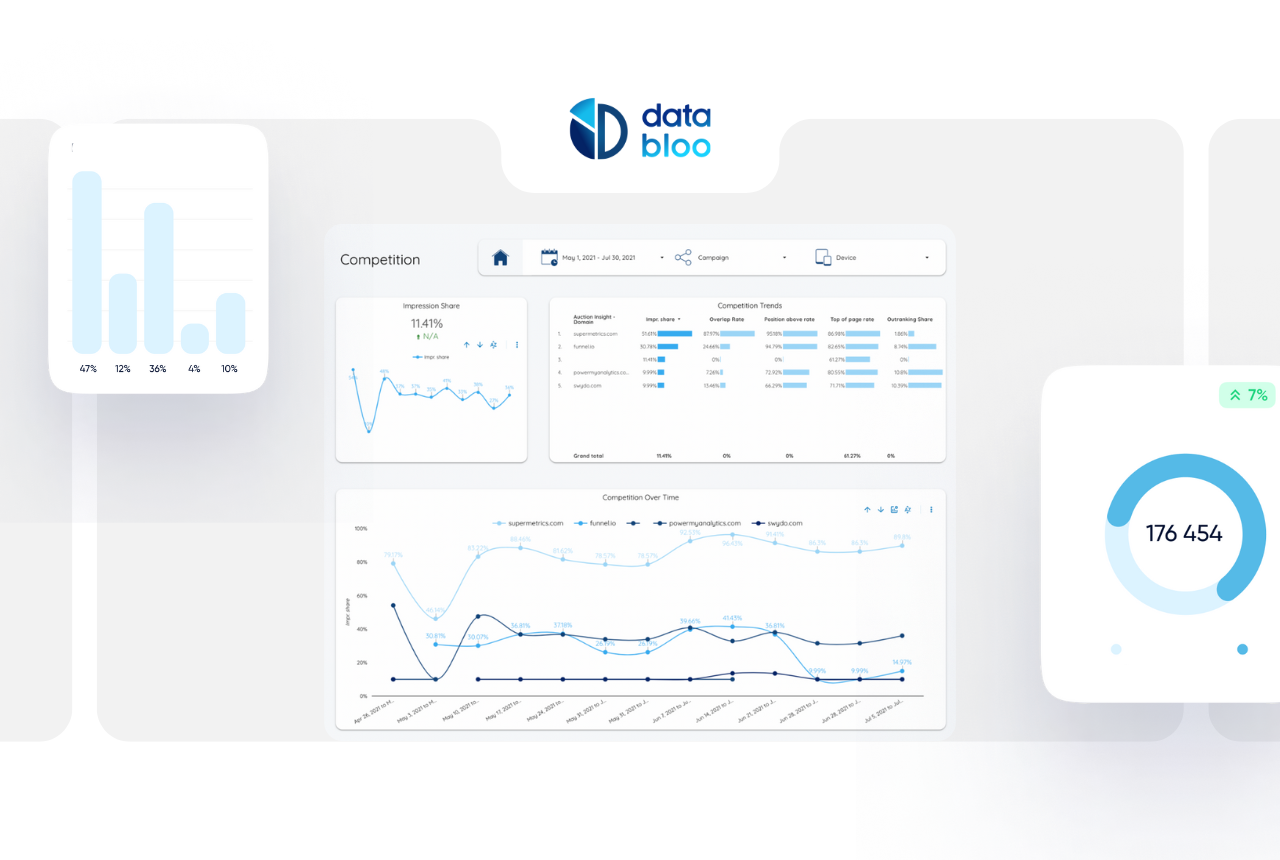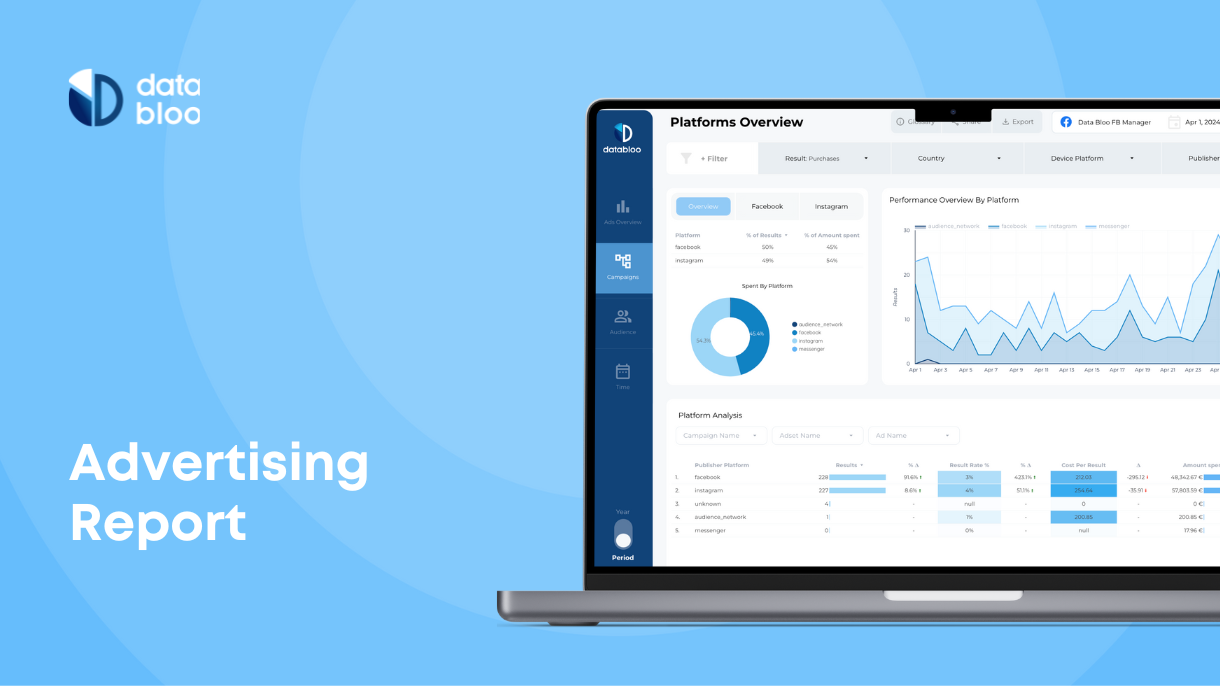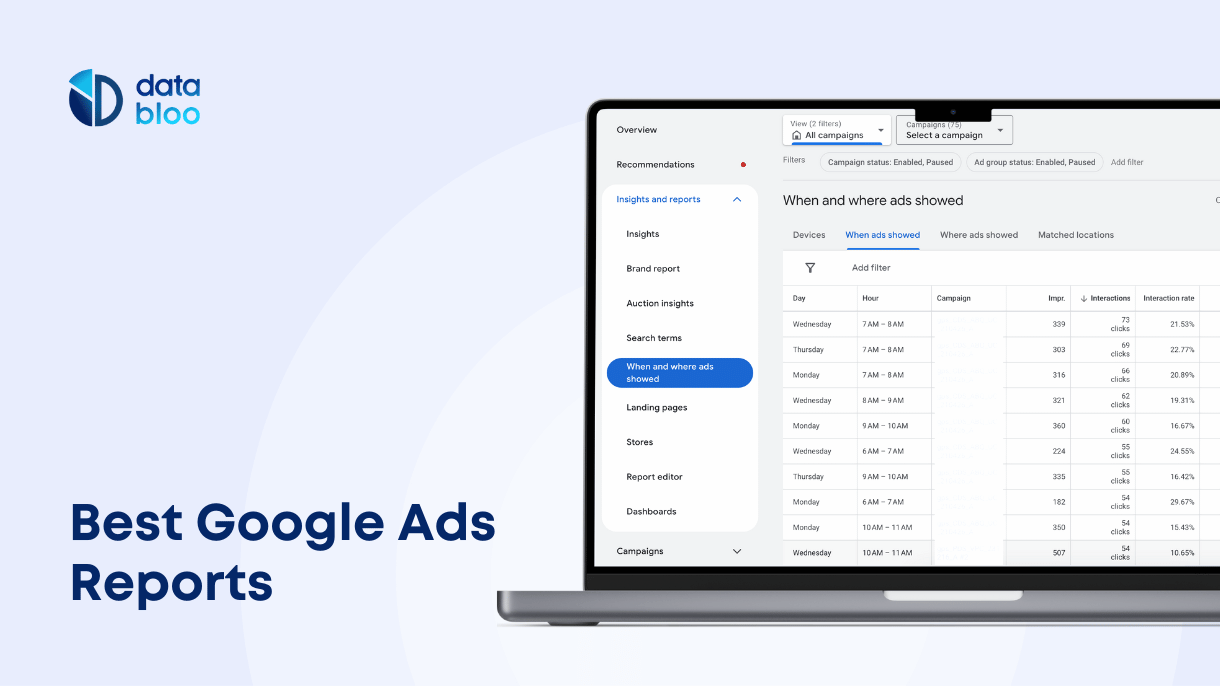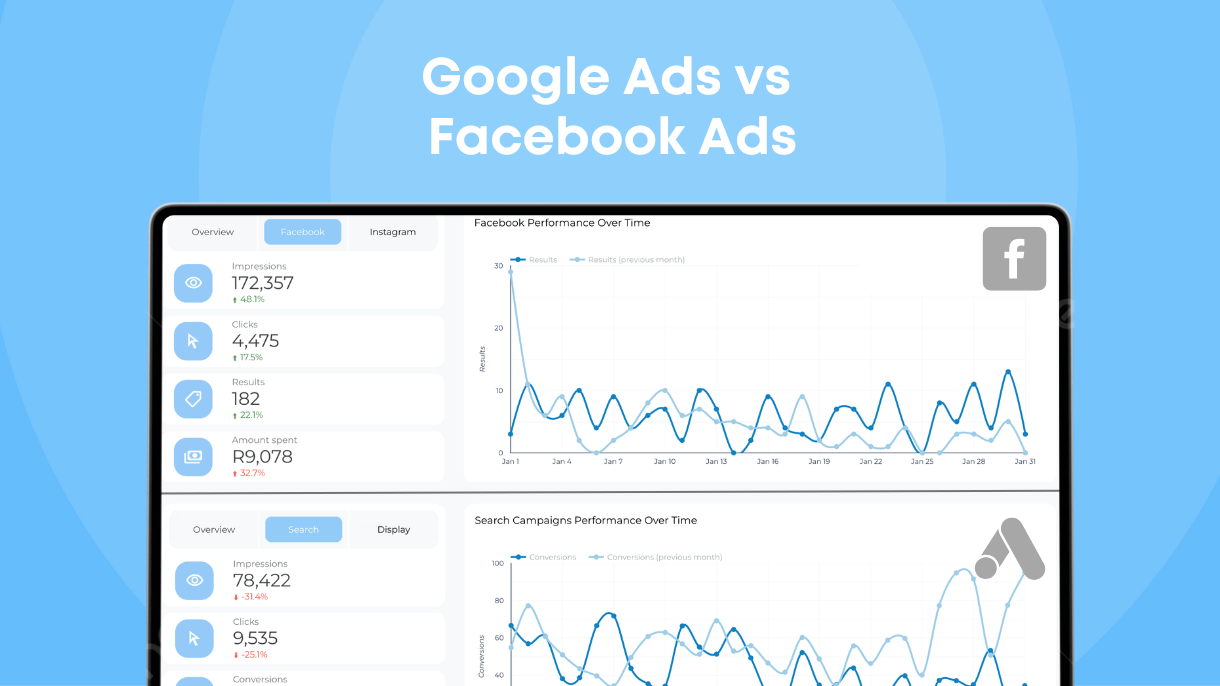Table of Contents
Every PPC campaign starts with a competitive PPC (pay-per-click) analysis. Or at least should start.
Rarely will you be the only one bidding for a keyword with no competition, and even when that’s the case, be prepared that other players will catch up soon.
But there’s good news. The better you become at competitive PPC analysis, the better will be your pay-per-click campaigns in general.
In this guide, you will learn how to quickly identify bidding opportunities, how to analyze your competitors’ ads, and how to use PPC competitive analysis tools to gain advantage even in the most competitive niches.
Why Perform Competitive PPC Analysis?
Studying your competition is an essential part of any digital marketing strategy, but competitive PPC analysis yields a set of unique benefits, be it for the success of your advertising campaigns or your overall digital growth.
Here are the main reasons to perform PPC competitive analysis on a regular basis:
- Identify market gaps. There are two types of gaps in the PPC world: the ones where you are behind and the ones where you’re ahead.
PPC competitive analysis will help you find both: quickly close gaps where your competitors are doing something you’re not AND find where your competitors are slow (e.g. tuning into the newest ad platforms or new features that change how ads perform on existing platforms) and use that to get ahead of your competition.
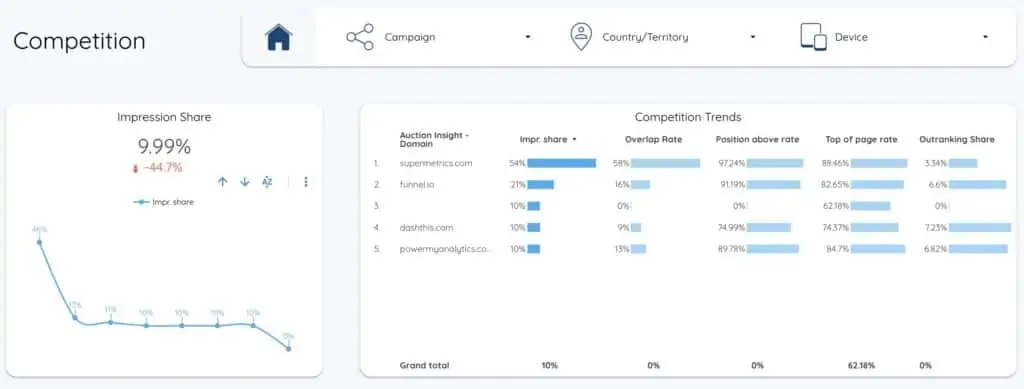
- Budget allocation. Understand how competitors allocate their budgets across different campaigns, keywords, and ad platforms to optimize your own spending.
- Improve other areas of digital marketing: PPC analysis is not just about ads. It’s the process of analyzing the entire sales funnel of your competitors.
Doing so regularly will help you improve not just your ad strategy but also other facets of your digital marketing, including content marketing, landing page flow, conversion, and user experience (UX).
- ROI-driven Improvement: Thanks to PPC analysis tools, PPC competitive analysis can be extremely data-driven. There’s no guesswork involved when you know exactly how your campaigns measure up and where to improve your bottom line.
- Keyword insights. Finding good keywords for your market takes time. But once found they will help you attract the right audience and can be reused in other aspects of marketing such as content and buyer persona design.
PPC competitive analysis is the fastest way to discover new keywords that your prominent competitors are targeting and start using them without spending much time on proprietary research.
How to Perform Competitive PPC analysis
Step 1. Focus On One Platform
Concentrate on analyzing a single platform to understand your competitors better.
There’s always an allure to gain a wider perspective by analyzing all platforms available to you at once, but you risk spreading your attention too thin and obtaining generic insights at best.
Every platform, even in the same niche, will have a diverse set of competitors for analysis and unique context. If you are going to advertise on several platforms, make a list, pick your priorities, and perform competitive PPC analysis for each separately.
Pro Tip: When you are targeting several platforms, use a multi-channel PPC dashboard for comparing performance of your different advertising channels.
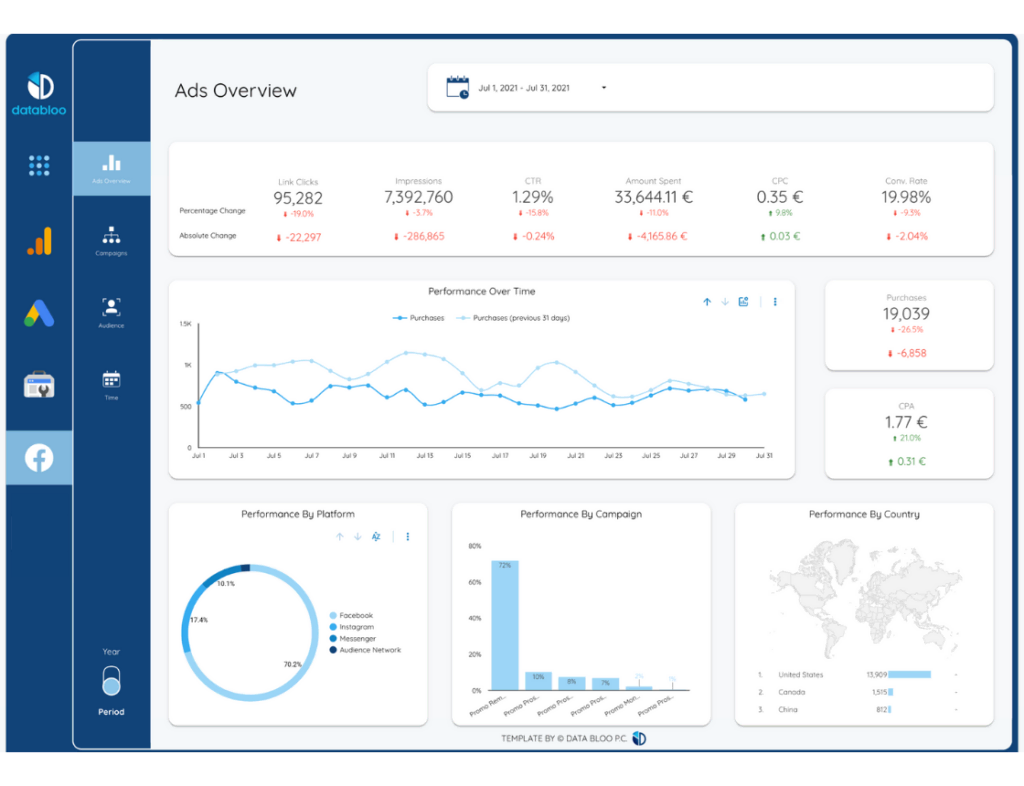
Step 2. Identify Competitors
Use tools to pinpoint who is competing for the same keywords. Note their ad copy and landing pages. This is crucial for understanding their strategies and positioning.
We are covering competitive PPC analysis tools and how to use them in the next chapter.
Step 3. Analyze Keyword Strategies
Examine competitors’ keyword targeting strategies. Look for gaps and opportunities in long-tail keywords to avoid bidding wars and find cost-effective niches.
Step 4. Dissect Ad Copy and Landing Pages
Study competitors’ ad copy and landing pages for persuasion and conversion strategies. Effective messaging and design can reveal tactics to incorporate into your campaigns.
Step 5. Monitor Bidding Strategies
Keep an eye on bidding dynamics. Engage in “sniping” by targeting underutilized keywords that competitors may overlook, allowing for efficient budget use and improved ROI, but never depends on just one tactic as bigger competition might start outbidding you.
Step 6. Track Performance Metrics
Utilize performance metrics like CTR, conversion rates, and CPA to benchmark against competitors. Adjust your strategies based on these insights to improve your campaign’s efficiency.
Step 7. Analyze Your Performance Across Multiple Platforms
Your past performance is your benchmark. Continuously analyze results across platforms in real-time to identify your strongest channels and optimize accordingly for better performance.
Always use historical data to analyze performance of your PPC campaigns over time. Remember, your competition is also analyzing your campaigns and their actions will affect your KPIs.
Best Tools for Competitive PPC Analysis
Some of your competitors already poured tens of thousands of dollars to develop the most efficient ad formats for their niche.
Using pay-per-click analysis tools, you can quickly catch up by studying what works and understand your competition’s overall advertising strategy.
The following tools will help you understand:
- What keywords your competition targets
- What copy they are using
- How much they are spending
- What are their best performing formats
- How much traffic they are driving
- What’s their overall advertising strategy
Free Competitive PPC Analysis Tools
You don’t have to invest hundreds of dollars to start PPC analysis. IN fact, some of the best tools on the market are free.
- Google Ads Transparency Center
- Google Keyword Planner
- Similar Web
Google Ads Transparency Center
The Google Ads Transparency Center is an invaluable resource for Pay-Per-Click (PPC) competitive analysis, offering a searchable database that reveals all advertisements a company has run across Google’s platforms.
By providing detailed insights into competitors’ and strategies, formats, and targeting regions, it enables marketers to refine their own PPC campaigns with enhanced understanding and strategic positioning.
Key Features:
- Filter by formats. Select formats you want to focus on: image, text, or video ads.
- Regional search. Learn about the geographical regions and demographics targeted by competitors.
- Historical data. See what ads competitors were running over a specific timeframe.
- Context. Seeing all the ads in the same interface will help you better understand the general tone that specific competitors use now and will probably use in their future campaigns.
Questions you can answer with Google Ads Transparency Center
- How do competitors structure their ad copy and creative assets across different platforms?
- Can we identify seasonal or event-driven advertising trends within our industry based on competitors’ ad timing?
- How does the diversity of a competitor’s ad portfolio reflect their market segmentation and targeting strategy?
- Which geographic locations are being heavily targeted by competitors, and how does it align with their market presence?
Workflows:
- Can be accessed via Google Search. Click on three dots next to the competitor ad in the search and then click “See more ads” to quickly see all ads they are running.
- Combine with manual search. Most useful when you are checking keywords in Google search, as you can quickly switch between Google Ads Transparency center, organic search results, and competitors landing pages.
Keyword Planner
Google Keyword Planner offers deep insights into keyword research and trends that shape the digital advertising landscape. The tool will gain you access to a wealth of data on search volume, keyword competition, and predictive ad spend, enabling a strategic edge in PPC campaign planning.
Key Features:
- Keyword Discovery. Find a vast array of keywords related to your business or sector, along with variations and synonyms, to broaden your advertising reach.
- Search Volume Trends. Analyze the popularity of specific keywords over time to identify trends and seasonality, aiding in the timing and relevance of your campaigns.
- Competition Level. Understand the competitive landscape for chosen keywords, including how many advertisers are bidding on those keywords, to better strategize your bid placements.
- Cost-Per-Click (CPC) Estimates. Get estimates on the average cost per click for your selected keywords, helping in budget forecasting and bid strategy.
- Ad Group Ideas. Receive suggestions for ad group structuring based on keyword analysis, optimizing your campaign’s organizational flow.
Questions you can answer with Google Keyword Planner:
- What are the emerging keywords in our industry, and how can we capitalize on them before our competitors do?
- How do seasonal fluctuations affect search volume for our key products or services, and how should we adjust our ad spend accordingly?
- What is the competitive landscape for our primary keywords, and how can we adjust our strategies to maintain or improve our visibility?
- How do the CPC trends for our targeted keywords inform our budgeting and bid strategies for more efficient ad spending?
Workflows:
- Integration with Google Ads. Directly link your keyword research to your Google Ads account, allowing for seamless transition from planning to execution.
- Historical Metrics Analysis. Utilize historical data to understand past performance and predict future trends, enhancing your keyword selection process.
- Customizable Timeframes. Filter search volume and trends by specific time periods to align your campaigns with expected peak times for your target audience.
Similar Web
SimilarWeb offers insights into web traffic and digital behavior across industries. The free version of the web app enables marketers to dissect the online presence of competitors, understand audience engagement, and benchmark performance against industry standards, fostering a wider understanding of context for your PPC campaigns.
Key Features:
- Traffic Analysis. Delve into the volume, sources, and geographical distribution of traffic to any website, providing a clear picture of your competitors’ online visibility and reach.
- Engagement Metrics. Gauge the depth of audience engagement through metrics such as bounce rate, pages per visit, and average visit duration, to understand the effectiveness of content and user experience.
- Audience Demographics. Uncover detailed demographic information about your competitors’ audiences, including age, gender, and interests, for targeted ad campaign planning.
Questions you can answer with SimilarWeb:
- Which competitors are capturing the largest share of web traffic in our industry, and through what channels?
- What content and user experience strategies are proving most effective in engaging audiences within our market segment?
- How can we tailor our PPC campaigns to better align with the demographics of our target audience based on competitor analysis?
- Where are the untapped opportunities in keyword strategy that can drive higher ROI for our PPC efforts?
Workflows:
- Competitive Benchmarking. Regularly compare your web traffic and engagement metrics against competitors to identify trends, shifts in market dynamics, and areas for strategic improvement.
- Audience Analysis. Deep dive into the audience characteristics and behaviors of competitor sites to refine targeting and segmentation strategies for your PPC campaigns.
Paid Competitive PPC Analysis Tools
Below are the most commonly used paid tools for competitive PPC analysis and their advantages over free tools.
- Semrush
- Spyfu
- Marin Software
- Social Media PPC tools
Semrush
Semrush is not just one tool, but a suite of tools for Pay-Per-Click (PPC) competitive analysis. It can provide actionable insights into competitors’ strategies, keyword effectiveness, and market trends, empowering users to optimize their PPC campaigns for maximum impact.
Tip: Semrush might be a pricier option as the service also provides robust SEO and content analysis tools in the same app.
Key Features:
- Ad copy and keyword analysis. Review and analyze competitors’ ad copies and landing pages to benchmark against industry standards and uncover effective messaging and design practices.
- Budget and traffic estimates. Analyze the advertising expenditures and visitor metrics of your competitors to gauge the effectiveness and scale of their pay-per-click (PPC) campaigns.
- Advanced filtering. Apply sophisticated filters to organize data by search volume, keyword complexity, cost per click (CPC), competitive density, and additional parameters.
- Position tracking. Position Tracking keeps daily tabs on your website’s rankings for a selection of keywords you’re targeting in your Google PPC advertisements.
Questions you can answer with Semrush:
- What are the most effective keywords and ad strategies employed by our competitors, and how can we adapt these for our advantage?
- Which competitors are driving the most traffic from paid versus organic search, and what does this indicate about their digital marketing priorities?
Workflows:
- Strategic Keyword Planning. Utilize Semrush’s keyword research tools to develop a targeted list of high-value keywords for your PPC campaigns, based on competitive intelligence and market trends.
- Automated reporting. Set up automatic delivery of daily, weekly, or monthly PPC reports directly to your own, your clients’, or your coworkers’ email inboxes.
- CSV export. Filtered data can be exported in CSV format if you prefer Excel or Google Spreadsheet for further analysis or plan to manually export data into custom reporting tools.
SpyFu
SpyFu is a tool created specifically for competitive PPC analysis. It provides deep insights into ad spend, keyword choices, and overall digital marketing approach, enabling users to refine their own PPC efforts for enhanced performance based on what their competitors do..
Key Features:
- Competitor ad budget and keyword performance. SpyFu offers detailed insights into how much your competitors are spending on PPC ads and how their chosen keywords are performing, allowing for a thorough understanding of their investment and its outcomes.
- PPC timeframe keyword tracking. Track the performance of specific keywords over time, including those you are bidding on, to understand how changes in strategy affect your rankings and visibility compared to your competitors.
- Custom reporting. Get comprehensive reports on the PPC landscape within your industry, including competitor strategies, market trends, and opportunities for growth in your own campaigns.
Questions you can answer with SpyFu:
- How are our competitors allocating their PPC budgets, and what insights can we gain from their spending patterns to enhance our own strategy?
- What specific keywords and ad strategies are driving success for competitors, and how can we incorporate these findings to improve our PPC performance?
Workflows:
- Enhanced competitive insight. Use SpyFu to conduct an in-depth analysis of your competitors’ PPC strategies, including their most successful keywords, ad spend, and campaign structures, to uncover actionable strategies for your own campaigns.
Marin Software
While not a strictly PPC competitive analysis tool, Marin Software offers a different angle on PPC management, focusing on the optimization and management of advertisements across various platforms. Its platform enables advertisers to manage, measure, and optimize their paid marketing campaigns across search, social, and display ads, providing a holistic view of their advertising efforts.
When using Marin Software, your competitors will be your own different PPC channels: study best performing ones and scale down lackluster campaigns.
Key features:
- Holistic campaign analysis and optimization. Utilize Marin Software to aggregate data from all your PPC campaigns across different platforms. AAdjust bids, shift budgets, and refine targeting criteria to ensure best possible ROI.
- Automated bidding strategies. Set specific goals, such as maximizing clicks or achieving a target CPA (Cost Per Acquisition), and let the system automatically adjust bids in real-time based on performance data and machine learning predictions.
Social Media PPC Competitive Analysis Tools
The tools you choose for social media PPC analysis will depend on what target you’re most focused on, as some of them might be an overkill or costing too much, especially if your social media presence is not your priority.
HootSuite
Enables scheduling and performance analysis of social media PPC campaigns across multiple platforms. It’s comprehensive but can be complex for new users.
Social Sprite
Provides straightforward analytics for social media PPC, focusing on ad performance and engagement metrics. It may lack advanced features for larger campaigns.
Keyhole
Offers real-time social media analytics and influencer tracking for PPC analysis, with a focus on hashtag and keyword performance. However, its depth can overwhelm beginners.
Never Skip a Competitive PPC Analysis Day
In the ever-evolving landscape of digital marketing, understanding the nuances of competitive PPC analysis is not just an advantage — it’s a necessity.
Remember, the goal is not merely to replicate what others are doing but to identify gaps and opportunities that align with your unique brand proposition and audience needs.
As you embark on or continue your journey with competitive PPC analysis, keep in mind the dynamic nature of digital advertising. What works today might not work tomorrow. Stay adaptable, and use the insights gleaned from your analysis as a springboard for experimentation and continuous improvement.

